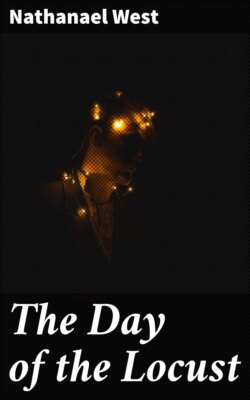Читать книгу The Day of the Locust - Nathanael West - Страница 8
7
ОглавлениеTod was right about one thing at least. Like most of the people he was interested in, Homer was a Middle-Westerner. He came from a little town near Des Moines, Iowa, called Wayneville, where he had worked for twenty years in a hotel.
One day, while sitting in the park in the rain, he had caught cold and his cold developed into pneumonia. When he came out of the hospital, he found that the hotel had hired a new bookkeeper. They offered to take him on again, but his doctor advised him to go to California for a rest. The doctor had an authoritative manner, so Homer left Wayneville for the Coast.
After living for a week in a railroad hotel in Los Angeles, he rented a cottage in Pinyon Canyon. It was only the second house the real estate agent showed him, but he took it because he was tired and because the agent was a bully.
He rather liked the way the cottage was located. It was the last house in the canyon and the hills rose directly behind the garage. They were covered with lupines, Canterbury bells, poppies, and several varieties of large yellow daisy. There were also some scrub pines, Joshua and eucalyptus trees. The agent told him that he would see doves and plumed quail, but during all the time he lived there, he saw only a few large, black velvet spiders and a lizard. He grew very fond of the lizard.
The house was cheap because it was hard to rent. Most of the people who took cottages in that neighborhood wanted them to be “Spanish” and this one, so the agent claimed, was “Irish.” Homer thought that the place looked kind of queer, but the agent insisted that it was cute.
The house was queer. It had an enormous and very crooked stone chimney, little dormer windows with big hoods and a thatched roof that came down very low on both sides of the front door. This door was of gumwood painted like fumed oak and it hung on enormous hinges. Although made by machine, the hinges had been carefully stamped to appear hand-forged. The same kind of care and skill had been used to make the roof thatching, which was not really straw but heavy fireproof paper colored and ribbed to look like straw.
The prevailing taste had been followed in the living room. It was “Spanish.” The walls were pale orange flecked with pink and on them hung several silk armorial banners in red and gold. A big galleon stood on the mantelpiece. Its hull was plaster, its sails paper and its rigging wire. In the fireplace was a variety of cactus in gaily colored Mexican pots. Some of the plants were made of rubber and cork; others were real.
The room was lit by wall fixtures in the shape of galleons with pointed amber bulbs projecting from their decks. The table held a lamp with a paper shade, oiled to look like parchment, that had several more galleons painted on it. On each side of the windows red velvet draperies hung from black, double-headed spears.
The furniture consisted of a heavy couch that had fat monks for legs and was covered with faded red damask, and three swollen armchairs, also red. In the center of the room was a very long mahogany table. It was of the trestle type and studded with large-headed bronze nails. Beside each of the chairs was a small end table, the same color and design as the big one, but with a colored tile let into the top.
In the two small bedrooms still another style had been used. This the agent had called “New England.” There was a spool bed made of iron grained like wood, a Windsor chair of the kind frequently seen in tea shops, and a Governor Winthrop dresser painted to look like unpainted pine. On the floor was a small hooked rug. On the wall facing the dresser was a colored etching of a snowbound Connecticut farmhouse, complete with wolf. Both of these rooms were exactly alike in every detail. Even the pictures were duplicates.
There was also a bathroom and a kitchen.
